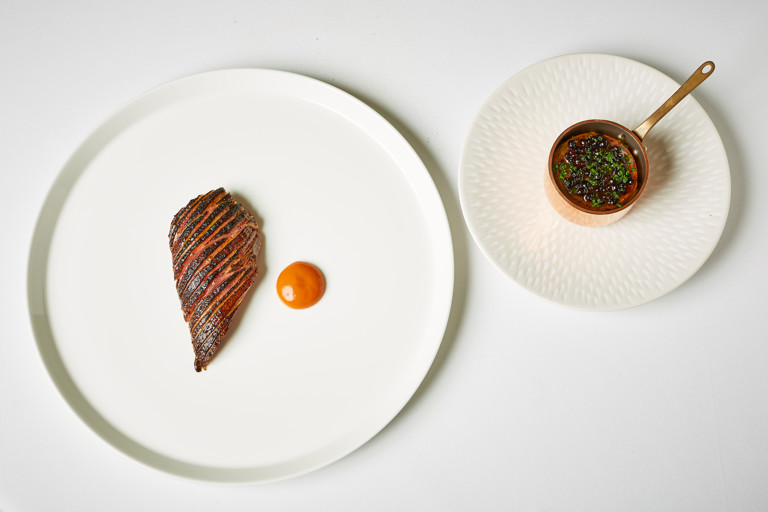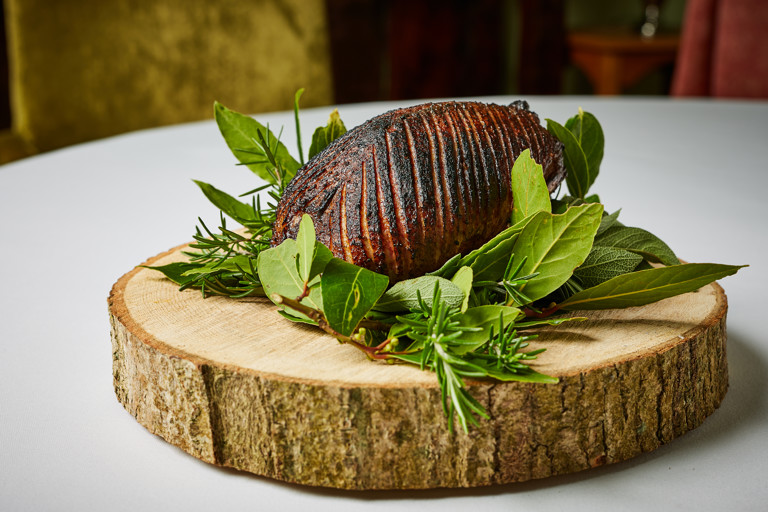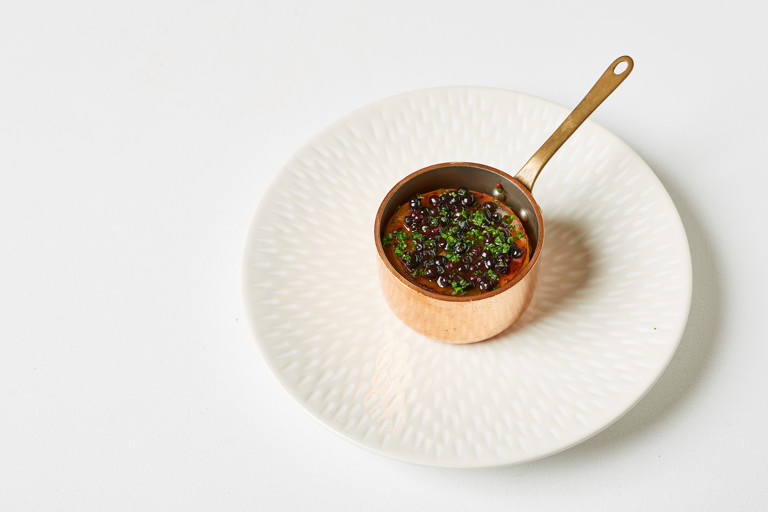Wild Hampshire mallard with rosehip and a swede and hazelnut hotpot
- medium
- 4
- 1 hour 30 minutes plus 4 hours for the duck legs and overnight drying time for the duck skin
This spectacular mallard (wild duck) main course looks beautiful carved at the table on a bed of herbs. The perfectly cooked crown is served with a mini hotpot made from the shredded duck legs, hazelnuts and crushed swede and topped with pickled elderberries. If you have leftover elderberries, try out Matt Whitfield's venison recipe.
Ingredients
Metric
Imperial
Duck
- 2 mallards
- 2 tbsp of honey
Hotpot
- 1/2 swede
- 100g of roasted hazelnuts, roughly chopped
- 1 handful of tarragon, parsley, chives and chervil (equal parts)
- 1 knob of butter
- 4 tbsp of meat jus
Pickled elderberries
- 100ml of white wine vinegar
- 100ml of water
- 50g of sugar
- 200g of elderberries, washed and stalks removed
Rosehip purée
- 250g of rosehips
- 3g of sugar
- 1 dash of white wine vinegar, to taste
Equipment
- Blender
- Ring cutter
Method
Prepare the mallards a day in advance to dry out the skin. Remove and reserve the legs and cut out and discard the wishbones (and the guts if still attached). Lightly score the skin and place in the fridge uncovered for a day so the skin can dry out – this will result in a crispier skin when cooked
- 2 mallards
The elderberries also need pickling overnight. Place the water, vinegar and sugar into a pan and bring to the boil. Put the elderberries into a container and pour the hot liquid over. Let the pickle cool before sealing, then leave for 24 hours before using
- 100ml of white wine vinegar
- 100ml of water
- 50g of sugar
- 200g of elderberries, washed and stalks removed
The legs can also be cooked in advance. Preheat an oven to 120ºC/gas mark ½. Place the legs in an oven tray or dish and season with salt and pepper. Slowly roast the legs for at least 4 hours, or until the meat is falling off the bone. Once cooked, leave until cool enough to handle then pick the meat from the bones. Reserve the shredded meat in a container in the fridge
Place the rosehips in a pan and cover with water, the sugar and a few drops of vinegar. Simmer until soft, then blend and pass through a sieve to remove the seeds. Transfer to a squeezy bottle and reserve in the fridge (any purée not used for this dish can be frozen)
- 250g of rosehips
- 3g of sugar
- 1 dash of white wine vinegar, to taste
On the day you plan to serve, preheat the oven to 180ºC/gas mark 4. Peel the swede and wrap in foil with salt and oil, then roast for an hour or until soft. Leave to cool and, once cool enough to handle, use a ring cutter the size of your hotpot serving pans or ramekins to cut out 4 discs around 5mm thick. Place a large frying pan over a high heat with a dash of oil and colour the slices a little on each side, then set aside. Dice the rest of the swede and crush with a pinch of salt and pepper
- 1 swede
- 1 dash of vegetable oil
- salt
- freshly ground black pepper
To cook the mallard crowns, turn the oven up to 220ºC/gas mark 7. Ensure the birds are at room temperature before cooking. Brush the skin with honey, season with salt then place in the oven for 6 minutes. Turn the crowns upside-down then cook for a further 2 minutes. Remove from the oven and blowtorch the skin until blackened. Leave to rest covered in foil for a good 30-40 minutes – the residual heat from the brief but fierce blast in the oven will ensure perfectly pink meat
To assemble the hotpot, heat up the crushed swede and the picked leg meat in a pan. Stir in the hazelnuts, chopped herbs (reserving 4 pinches to garnish) and a knob of butter to loosen the mixture a little. Taste and season with salt and pepper, then divide into the serving pans or ramekins and top with the swede discs
- 100g of roasted hazelnuts, roughly chopped
- 1 handful of tarragon, parsley, chives and chervil (equal parts)
- 1 knob of butter
- salt
- freshly ground black pepper
Spoon some jus over the discs of swede then place the hotpots under the grill until bubbling. Top with pickled elderberries and the reserved chopped herbs
- 4 tbsp of meat jus
Carve the breasts off the rested mallards and transfer to the serving plates. Add a dot of rose hip pureé beside it and serve with the hotpot on the side
Get in touch
Please sign in or register to send a comment to Great British Chefs.




